When it comes to running hydration there are plenty of options for carrying water, including my personal favorite the running hydration pack. Below is a detailed breakdown of different tested vests and the pro/cons of each from price point to hydration bladders.
If you think you can skimp on hydration during your runs, eventually it will catch up to you.
I speak from unfortunate experience many years ago that taught me there’s really no reason not to pull on my pack.
It’s no surprise that even the simplicity of water has become an area of confusion for many runners as studies change each week:
- drink before you’re thirsty…no, no this could lead to overhydration (hyponatremia),
- take in your body weight x’s 1 or 2 or 3
- drink less
- drink more
- throw your hands up and wave ‘em around…
What’s a runner to do?
Learn to trust your body and of course test all advice before race day.
On training runs for long distances, learning that you MUST carry water usually happens after a few whoops sessions like I had. You are smarter and thus ready to avoid it with the right running hydration vest or handheld.
In this article, you’ll learn everything you need to know about picking the right hydration pack, what are the best options out there, and I’ll also answer some of your most frequently asked questions about hydration packs.
How to Carry Water While Running?
One of the biggest frustrations for many runners is finding the right method to carry water.
For some reason, road runners seem resistant to wear hydration packs, but I’ll tell you once I started wearing one I haven’t looked back.
I reached out on Facebook to get your feedback and the options were pretty varied from handhelds to running belts to vests with no particular consensus other than different strokes for different folks.
One of the benefits to carrying your own water is being able to sip it rather than feeling rushed to slug it down or not having it when you want it. Guzzling your water can lead to stomach cramps.
Here are the pro’s and con’s of some different sizes and methods of carrying water:
- Hydration pack — hands free, easy to sip anytime, can be hot and more clean up time, my favorites are researched and more details provided below
- Handheld small Nathan Speed Shot – light, fits to palm, 12 oz and pocket, but can change your arm swing
- Handheld that forms to hand from Amphipod — keeps water cold, plenty of fluids, 16 oz, same arm swing issue
- Running Belts– extra storage, good volume, I like water in one and electrolytes in the other. Since many large marathons are banning hydration packs, these are a great option.
- Stash water/water fountains – nothing to carry, but pre-planning required
- Beer hat — sometimes you just need to party (kidding…but send me a photo)
Interested in learning more? Keep reading to find out all there is to buy the best hydration pack for you.
7 Best Running Hydration Packs
Over the years I’ve been lucky to test out a variety of running hydration vests. Some I have truly hated, others had the comfortable fit that made me realize it was a piece of gear I couldn’t do without.
Suddenly, thanks to a zippered pocket I could carry my iPhone for photos (oh and safety), along with water, some tissues, energy bites for running fuel, car keys, sunglasses, safety alarm, you know…all kinds of stuff.
It doesn’t change my stride or bounce around.
It has my long runs so much easier.
What’s the best running hydration pack?
The best pack is going to be one that fits snug to your body so that it doesn’t bounce around, isn’t larger than you need for most runs and provides you with the pockets for quick access to things.
- I like a front pocket to put in a running flask with electrolytes (you can put them in a hydration bladder, but that’s more cleaning)
- A pack that’s not huge (in terms of storage) because we don’t need the same volume of water as someone doing a big hiking trip.
- Must have a pack that can be adjusted to fit tight to the body to prevent chafing.
- Adjustable straps so that it goes with me from summer to extra layers in the winter.
✅Camelbak Circuit Hydration Vest ($83) – Low Cost Option
Ok they keep changing the model so it used to be closer to $60, but still decent. Mind you it’s supposed to be one size fits all.
Over the years, CamelBak has become synonymous with on-the-go hydration, and for a good reason! The recently updated Circuit is one of their most popular running bests and a great one to start off with.
With the CamelBak Circuit, you get a lightweight hydration vest that includes a reliable 1.5-liter reservoir. The vest also features a zippered cellphone pocket, the reservoir with a functional open and close valve, and two flask pockets for additional bottle storage.
It’s made of a breathable mesh that keeps air flowing while you run and break a sweat. The vest also features added reflectivity, which helps a great deal in terms of visibility for earning morning or late-night runs.
With the CamelBak Circuit, you get dual adjustable sternum straps that offer a range of adjustments for a custom fit and allow for increased stability as well.
In case you’re looking for a vest that comes in multiple sizes, this is probably not the one for you. The Circuit is for people with chest sizes anywhere from 28 to 50 inches.
This is actually the very similar to the marathon vest that I used for a good 4-5 years. I like that the pockets are in front so I can easily grab my phone and am not carrying more water than needed.
It tightens to fit close to my body. In fact, I don’t feel it moving and don’t hear water sloshing around, which oddly bothers me.
Although the back is a breathable mesh, though don’t let that fool you…you’re still going to sweat.
Camelbak Classic Light ($75)- Most Minimal Running Pack
This is no frills, no pockets, just gimmie a bladder for my water and lets go. Its breathable mesh with large holes allows you to stay cooler and you’ll barely even notice the vest while wearing it!
The Nano can hold two soft flasks on the front and also features a dedicated cellphone and key pocket. The side pockets on this vest allow you to store food and other gear. You can even store your trekking pole in the back. It’s a great option if you’re going for a minimalist look and feel!
Nathan Pinnacle 4L ($174) – Great for Carrying Multiple Types of Fuel
This is my new favorite, having finally switched from the Camelbak. I like being able to carry collapsible flasks with Tailwind in one and water in the other. The back of this isn’t padded, so there’s also less to make me sweaty.
Nathan is an incredible brand and is one of the biggest and most reputable ones when it comes to running hydration. Their Pinnacle is amongst the best on the market. It comes in two sizes: 4L and 12L.
The pack’s long fit ensures an even distribution of weight centered on the back for a more comfortable run. The 12 exterior pockets, including two water-resistant zip pockets at the front, make it incredibly easy to stash away important things.
The material used is soft, stretchy, and prioritizes comfort and a bounce-free run. It’s known to slip on like T-shirt and feel comfortable even on longer runs. The tapered back also helps help encourage moisture to stay away from the skin.
The Pinnacle also comes with an insulated bladder that helps keep water cool on hot days. You can also stash away two additional 20-ounce soft flasks in the water-resistant chest straps on the front.
The vertical pocket is great for storing your trekking poles. With this pack, you’ll have plenty of space to store snacks, extra layers, etc. during a run.
Here’s why:
- I like that with two flasks I can carry water and an electrolyte
- I don’t have to clean out a bladder, but can 100% put one in for longer trail days
- It has an easy to reach phone pocket upfront
- Plenty of packs in the back for when I overdress or want to carry trekking poles
- It’s slim and works as a race vest
- Straws can be trimmed so they aren’t so long
I used this for our entire Moab trail adventure vacation and that sealed the deal, I’ll continue to use it. I also went with a small women’s size, which felt like a secure fit that doesn’t bounce around.
Bustier ladies, I don’t know that the straps on this would work well.
Ultimate Direction Vesta ($111) – Best for Tons of Pockets
Ultimate Direction’s Adventure Vesta is built to accommodate everything you need for a long day on the trail. It includes enough space and pockets for snacks, hydration, layers, and even a few safety items.
You get a total of 6 pockets with the Vesta. The front stretchy mesh storage can store your phone, some snacks for fuel, and even valuables. The total storage for this vest comes to 10.3L.
The new Comfort Cinch technology on the Vesta provides a nice, custom fit with easy on-the-go adjustments. It includes 4-way stretch material in key places to move with you and stay nice and snug. With the sliding rail sternum and waist straps, you’re bound to find a good fit.
It even has a new, redesigned trekking pole holder for your next trail run. It minimizes bounce and snaps out of the way when you’re not using it.
I’ve also run with this pack and again, as I mentioned above, it has tons of pockets. But I didn’t like that I needed to buy the bladder separately.
However, it’s a favorite among many of my runner friends who want to be able to take off jackets or gear as the weather changes.
It has more room in the pack to carry things, which makes it ideal for more trail running days where you need extra fuel and the weather is often changing on you.
Salomon Adv Skin 8L ($115) – Best for Shorter Torso
There are a few varieties here and I tested out one of their packs during my training at 12,000 feet in Wyoming and so I can say for sure it stayed put!
It’s the ultimate hydration pack for women with narrower chests and shoulders. It Salomon Advanced Skin features a curved front and tapered 500ml soft flasks with straws. This allows for a better fit against your chest and eliminates pressure on the chest as well when cinched tight.
It can even hold an additional bladder, loads of gear, and even your cellphone, thanks to the many pouches and zippered pockets it has. You’ll also get multiple pole holder solutions for versatile options in attaching poles.
I’ve also heard from shorter runners that they felt this was super comfortable on their torso. And while I am a tall runner, I have a very short torso and would 100% agree that where some packs feel like they are hitting my shorts and thus rubbing, I never had that issue with Salomon.
This one also had great pocket access in the front, which some smaller packs don’t. I would also say this is an outstanding choice for just about anyone.
And while it used to be on the higher end of price now they are also right in line with everyone else.
If you don’t need a full bladder or it’s super hot this Salomon Agile is super cool.
Black Diamond Distance 4 Hydration Vest ($149) – Lightweight Pack
If you’re looking for a lightweight hydration vest that stays put at high speeds, then this Black Diamond Distance 4 might be the one for you.
It’s designed to stay secure even at high speeds so it’s a great option for anyone that does interval runs or fast downhill sections often. This running vest has a snug fit with a very small and lightweight build and weighs only about seven ounces.
Despite its smaller size, it can fit two 500ml soft flasks on the front and a reservoir sleeve on the back. It also has ample pockets for storing your cellphone, keys, and other small gear items.
It features thin breathable mesh all over that allows heat to escape better than other bulkier vests. A rear pocket with a zipper is great in providing some weather-resistant storage to protect valuable gear.
Nathan VaporHowe ($115) – Smallest Sizing
One of the few vests that go down to an XXS, which is super important to ensure that you’re getting a good snug fit. In addition, we don’t want these bouncing around on us. Another one with easy front pockets and also 2 straps for best fit.
It’s lightweight with a 1.8L bladder and is specifically designed with the female form in mind. It’s form-fitting without being uncomfortable.
It has pockets all over for quick access to essentials, and it includes pockets inside other pockets! The weather-resistant chest pockets in the front of the vest are great for storing your cellphone and keys.
Salomon Sense Pro 10 ($180) – Best Lightweight Racing Hydration Pack
If you want to run light and fast, then you definitely have to consider the Salomon Sense Pro. The Sense Pro is a stripped-down version of the ADV Skin. It is made for racing with minimal materials, a small number of features, and a fit that can only be adjusted at the sternum.
The flexible material of the vest makes it feel more like a garment than most, reducing the chafing and restriction caused by some bulkier designs. The front storage is comparable to the ADV Skin’s including a zipper pocket on the left torso, and the rear compartment can be accessed from the top or the side.
The Sense Pro also includes Salomon’s updated Speed flasks, which have a wide mouth that works with modern water filters and a semi-rigid base that makes them easier to load when full.
The Sense Pro 10 is so slim that it doesn’t have room for a bladder. This means that the vest can only be used for races where you can refill your flasks at aid stations on a regular basis.
And for my female runners out there, Salomon also produces a women’s version with a more contoured fit and straws for easy drinking.
While I like the snug fit and underarm storage, it comes at the expense of ventilation and the thin material might wear and tear overtime.
The Sense Pro vest is a well-fitting, lightweight alternative that will keep you moving quickly on race day, but it might not be the best as a daily use hydration pack.
Osprey Duro/Dyna ($110) – Best Small Capacity
The 1.5-liter low-volume race-ready packs, the Osprey Duro 1.5 and Osprey Dyna 1.5, contain everything you need for a quick and light day of running.
The included 1.5-liter hydration reservoir fits in a zippered compartment in the back. Plus, there are two large stretch pockets on the front that can hold food, small items, or Osprey’s 500ml or 360ml soft flasks, which are sold separately and increase the pack’s hydration capacity.
Although there is an outside bungee cinch cord to carry a jacket or extra layer, it’s important to note that the back pocket can’t accommodate additional gear when the hydration bladder is in use.
The storage capacity is completed with a smaller front zip pocket and two stretch pockets under the arms for small items like a buff, hat, or gloves.
The rear hydration bladder pocket has a diagonal zipper opening that only allows the tubing to go over the right shoulder, which is something to consider if you prefer it on the left.
Instead of having a buckle in the middle, the sternum strap is held in place by plastic snaps that clip on each of the shoulder straps. This makes it simple to move the shoulder straps to a position that is comfortable for you.
If you have broad shoulders or arms, it is recommended that you order a size bigger from what you normally wear since this pack tends to run on the small side when it comes to the arm holes.
The material is slightly thicker and heavier than some of the other packs on th elist, but it is still quite breathable and durable.
Plus, this pack has a safety whistle on the front and a spot to attach trekking poles when you’re not using them. It has a lot of thoughtful details for a small pack and can hold as much water as many larger packs.
Nathan TrailMix Running Vest/Hydration Pack – Best for Trail Runners
The Nathan TrailMix Running Vest/Hydration Pack 7L is the most effective hydration pack for trail running. This ergonomic hydration pack won’t chafe or bounce and can be adjusted to fit your body perfectly.
It has a capacity of 7 liters, which allows you to store race fuel and other needs for running, and it comes with a 2-liter bladder that will keep you hydrated for miles on end.
This size works well for trail runners since it strikes a good mix between not being too large and still having enough storage for your running gear, fuel, and water.
There is a handy front storage compartment for your phone, a well-designed compression system for comfort and aerodynamic performance, and breathable mesh paneling for ventilation to keep you cool on the trails.
How to Choose a Hydration Pack for Running
Choosing the right hydration pack for running means figuring out what your typical run looks like. Do you run long distances? Do you want to use your hydration pack while trekking as well? Are you picking one for your next race?
If you only run a few miles per week, a recreational vest will do. If you want to race, you should go for something more technical and performance-oriented. A hydration pack may be used for day hikes, runs, and even overnight trips, making it a great option for those who value portability and versatility.
Consider the following factors while answering these questions to figure out which of the hydration packs mentioned above is the best one for you.
Types of Running Vests
Recreational
Recreational running vests are less expensive than technical choices. That makes them a great choice for someone who has never used a running vest before but wants to try one out.
The normal water capacity of a recreational running vest is 1-2 liters, which is adequate for a run of 1-2 hours or a race with loads of aid stations.
Typically, they feature one main compartment and a few smaller ones for stowing snacks, smartphones, and other things such as energy gels. But they won’t have all the bells and whistles of a pack that is made for performance.
Performance
Performance running vests can take on a variety of forms. But, generally, they tend to focus on long all-day runs, trail races, ultra marathons, and challenging terrain.
Performance running vests are often made of higher-quality fabrics, making them more comfortable over extended periods of time.
Also, they have a lot more features and ways to organize your stuff, like extra compartments, attachments for poles and/or ice axes, and unique ways to customize the fit.
Fastpacking
Fastpacking is a combination of long-distance trail running and backpacking. While packing minimal is essential for running or hiking quickly, you still need to have enough equipment to be safe and comfortable.
You need a pack that can move with you for a long time while still holding adequate gear for several days if you plan to fastpack. This is difficult to find, as many day-hiking backpacks are heavy and lack the features to transport the necessary gear, while backpacking backpacks are far too bulky.
As a result, fastpacking running vests and packs that bridge the gap between running vest and daypack have emerged. They are large enough to accommodate overnight gear while remaining close enough to the body to prevent distraction while running.
Bottles vs Reservoirs
Water can be carried in a number of various ways, depending on the sort of hydration pack or running vest you choose. How much water you want to bring with you depends on how far you’re going.
For a run lasting 1 to 2 hours, you will likely only need 1 liter of water. I n contrast, if you are out all day, you may need up to 3 to 4 liters of water. Most running vests can carry up to 3 liters of water, which includes a 2 liter reservoir and two 500ml flasks.
The majority of running vests and hydration packs have space in the back for a hydration reservoir. This looks like a pocket or sleeve where you could put a reservoir. The best options have a method to keep the reservoir from slipping down into the sleeve while you’re drinking.
Some of the options on this list have reservoirs, while others do not. That is something to think about before making a purchase. Consider the reservoir’s size as well. A 1 to 2 L reservoir can fit in most running vests and packs.
Some running vests have flask compartments on the front. When selecting a running vest, keep in mind that many of them also have flasks. Flasks should be placed so you can drink while running, which is essential for any type of running hydration.
Moreover, flasks may weigh less than reservoirs. Unfortunately, some tend to slip down or are difficult to reach without a lot of effort when running. Look for elastics that will keep flasks in place even when they are partially empty.
Many runners favor one method of hydrating over another, while others use both. Whichever method you use to hydrate, make sure you bring enough water for your run.
Total Capacity for Water and Gear
How much capacity you need will depend on what your runs usually look like. A runner whose typical distance is five miles on the road will have different requirements than one whose typical distance is twenty miles on the trails.
The storage capacity of running vests and hydration packs ranges between 2 and 20 liters. It normally specifies the size of the main compartment, but many have other pockets and features for storing gear.
Plus, consider what you might want to bring on most runs and choose a pack or vest that can accommodate that amount of gear.
If you’re going for a long run and believe you’ll be shedding some layers, the extra capacity featured in some of these packs might come in handy. On the other hand, if you’re only going for a short run, a lightweight vest with limited capacity might be the way to go.
It’ll also depend on the distance you’re planning on running. Longer distances generally entail the need for a larger capacity for water and gear.
Another thing to consider when figuring out how much water you need, think about whether you will be able to refill it and if that’s even feasible. How many aid stations are there if you’re running a race? How far apart are they from one another?
It’s not worth bringing more water than you need because it’ll just weigh you down but refilling the water can also take a while which might not be what you want if you’re aiming for a PR during a race.
Fit is very important for all gear, but especially for a running vest. While buying online, take the time to measure yourself and consult sizing charts.
Running vests should be snug and not move around at all. You want it to feel less like a backpack and more like a piece of clothing. When you run, you shouldn’t be able to feel it move.
To measure your size for a hydration pack, dress as you would for a run and measure the diameter of your torso. Then check the manufacturer’s details on the sizes to find the right fit.
For women, consider your length and torso circumference but also take your bust size into account when picking a hydration pack.
Breathability
When you’re out running, it’s necessary to wear and use breathable gear and clothing. Particularly during the colder months or in colder places, staying dry or drying quickly might be the difference between comfort and hyperthermia. In the summer, it might mean the difference between a sluggish run and a run that makes you feel good.
Several running vests are made from materials that are quick-drying or sweat wicking. Mesh fabrics can allow heat to escape and keep you cool. Alternatively, some vests and packs feature ventilation to keep you cool while moving.
If you know you sweat a lot, it’s important to think about how well a running vest or pack breathes.
Comfort
The best running vest doesn’t get in the way while you’re running. While trying on running vests, add some weight such as water and gear to them and run or bounce up and down to simulate running.
See if you notice your running vest a lot when running. This can potentially distract or worse chafe you in a long run.
Like any other piece of clothing or piece of gear, the best running vest is one that fits your body and meets your needs. There is no single ‘most comfortable’ vest, as what suits one runner may not fit another properly. may not fit your body.
Regardless, look for a snug fit with no bouncing or rubbing. Try to choose materials that are soft, have padding, and can be adjusted. All of these things will make you more comfortable, which will help you run better.
Other Features
Sometimes the difference between a good hydration pack and the one for you is the extra features it has. Depending on your running plan, look out for reflective materials, extra pockets, water-resistant pockets for electronics, and easy-to-use trekking pole keepers.
Zippered pockets: Front zippered pockets are excellent for phones to keep them from falling out of stretch pockets. Plus, look for water-resistant pockets for electronics if you plan on running when it rains.
Stretchy pockets: Stretchy pockets are great because they don’t take up space when you don’t need them to. Stretch pockets let you store more than would normally fit and prevent stuff from falling out even when the pocket isn’t closed.
Compression straps: Compression straps allow you to carry additional supplies on your pack or vest. It’s a great way to carry additional layers that won’t fit in your pack or to carry trekking poles if you don’t have another option. Plus, compression straps are versatile and can be used in a lot of different ways while running.
Trekking pole attachments: If you enjoy using trekking poles while running, having a place to store them when you’re done with them or reach a stretch of the path where you don’t need them is a good choice.
Ice axe attachment: Some running vests and packs have attachment points for ice axes, which can be useful for mountaineers who prefer to move quickly and lightly. Or, if you enjoy running in the mountains during snowy or icy seasons, lightweight ice axes can be useful for safety.
Reflective materials: Safety, visibility, and signaling are also important features to consider when looking for a running vest or pack. If you plan to run in low-light conditions or at night, having some reflective material on your running vest can increase your safety. Look for materials with reflective patches that will catch the light of cars and other people out while you run.
Frequently Asked Running Hydration Pack Questions
Finding the right hydration pack for running means answering a few key questions. As a running coach, I get asked quite a few questions about hydration packs on a regular basis. Here are answers to some of the top ones:
Do You Need a Hydration Running Pack?
No, it’s not a must.
I spent decades not running with one. However, now I can’t imagine running without it.
As noted we know holding something in your hand can alter your arm swing which is a big problem for running form. And I also like having quick access to water, my phone and a just in case granola bar when I’m doing 2 hour runs.
When Should You Wear a Hydration Pack?
A hydration pack can help you stay hydrated when jogging or exercising. Water bottles are not always easily accessible while running. As a result, using a hydration pack allows you to get to water quickly without interrupting your workout.
When running for extended periods of time, it’s a good idea to use a hydration pack. As a rule of thumb, we should drink 8 ounces of water every 20 minutes when running.
A hydration pack can be a crucial way to stay safe and hydrated if you are jogging for 30 minutes or more, especially in hot or dry conditions.
Will a Hydration Pack Change My Running Form?
Wearing a well-fitted hydration pack should not alter your running form, but it will take some getting used to. The main issue is learning to keep your shoulders relaxed during the run, which overworks your upper traps and leads to neck pain.
You’ll have a tendency to shrug until you get used to feeling something sitting on you. But the weight should never be enough to alter your form.
Hydration packs constructed of elastic and stretchy fabrics hug the body and keep the entire pack from bouncing around while you run.
Hydration Pack vs Vest?
Everything listed here could be referred to as either a hydration pack or a hydration vest.
When you start getting in to larger sizes, a hydration pack is often considered a backpack. It’s designed to carry gear for camping and a lot more food. That could become necessary for multi-day stage races, but it’s not what we’re looking at in terms of most marathon and trail running.
How Much Gear Capacity Do I Need in a Running Hydration Pack or Vest?
You can figure out how much capacity you’ll need in your running hydration vest based on the distance you plan on running. Any decent hydration vest will have plenty of room for drinks, snacks, and extra layers.
For runs lasting less than two hours, the Pinnacle with a couple of flasks is a great option with additional room to store small gear, snacks, and sunscreen.
For a longer run lasting up to three hours, you might want a little more capacity. In such a case, the Salomon Advanced Skin Series has a few great options to choose from. Pick anything from a Adv Skin 5 to Adv Skin 8 depending on how much gear you want to store.
For runs lasting longer than six hours, a rest with 4 to 12 liters of storage is ideal. The Nathan Pinnacle 4L or 12L are two great options to choose from!
How Can I Tell If My Running Hydration Pack Fits Well?
Look for a snug fit that prevents chafing and bouncing while you run. To measure your size for a hydration pack, dress as you would for a run and measure the diameter of your torso. This would be below your bust and/or at the top of your ribcage.
You can then read the brand’s guidelines to find the appropriate size for your measurements.
Which Hydration Pack Features Do I Need?
It all comes down to the sort of runner you are and the types of runs you prefer doing. You might also want different types of packs for different types of runs, depending on how long you run and what you’d want to store.
An everyday solo runner might like add-ons like an emergency whistle for safety, while a marathon runner might be looking for that additional capacity. If you trek regularly, trekking pole keepers are an additional feature to consider.
Do Marathon Runners Wear Hydration Packs?
Sometimes. As much as I love having my hydration pack in training, I actually love to shed it on race day and feel lighter.
What I will then do is carry a bottle with my electrolytes for the first half. In fact, I have some leggings with pockets where I can shove that bottle. Then toss it at an aid station and switch to water.
There is NO REAL RUNNER RULE prohibiting you from wearing one. So if it’s a hot race, if you have a super sensitive stomach and know what works for you, then wear it!
***NOTE sometimes there are rules! Like the Chicago Marathon or other large marathons that prohibit them for safety reasons.
Marathon Hydration Tips
You’ve read all about how dehydration impacts performance, so let’s instead talk about what to drink, when and the best options for carrying water on your training runs or race day.
As a long time runner, I have learned how to follow the cues of my body.
I don’t need to drink a great deal while running and when I did test out “the rules” it usually resulted in feeling bloated after running and nauseous. So not exactly conducive to a great run.
Following are what I’ve found to help me and also the runners I have coached over the years.
When to Drink Water While Running
One of the major complaints from runners is that feeling of slosh while running.
Some of this is due to waiting too long to drink and then guzzling, some of it is due to trying to follow running hydration guidelines that are causing us to take in more than needed.
Here are a few strategies to figure out your needs:
- Ensure 30-45 minutes pre-run you’ve had at least 8oz
- Start carrying water on every run (then you won’t forget on long runs)
- Try sipping it every mile
- Still feeling thirsty? Try sipping every couple of minutes
- Still thirsty? Check your pre-hydration again
If you don’t like the taste of flavored water, you can also take something like Salt Stick tablets before. And also during the run to help balance out sweat loss as well.
How to Drink From Cups on Race Day?
Slow down to grab the cup, squish together so you’ve created a peak on one end making it like a funnel.
Pour it in to your mouth and swish it around, rather than just gulping it! This will prevent sucking down air.
Continue with this sipping method and avoid chugging.
Some people prefer to walk through each aid station to ensure they get in water. I hate to lose momentum so I practice the sip or carrying my own water. Do what works for you.
Post-run, again it’s time to sip not guzzle which usually leads to stomach cramps while running. In fact, all the blood is currently diverted from your digestion. So you want to ease in both water and food.
For instance, one great way to do this is with a recovery smoothie which can contain a lot of hydrating foods along with water.
Is It Possible to Run a Full Marathon Without Drinking Any Water Fluids During the Run?
Yes.
Should you is a different question. But the answer I hope you know is no, it’s not ideal. In fact, you are sacrificing recovery by letting your body get into such a depleted state. And if you’re running in the heat, then you could be creating a major health issue.
So instead of trying to push yourself to some outside limit, SIP a little consistently.
What to Drink During the Marathon?
Do you need a sports drink? No. Skip the artificial chemicals (nothing in nature is neon).
Do you need electrolytes, probably (depends on the distance). Learn more about electrolytes and how they impact your running.
If your answer is yes to any of these, adding some electrolytes to your water can help:
- Are you a heavy sweater?
- Is it a longer run than normal?
- Have you been feeling fatigued on recent runs?
- Do you have muscle cramps during or post-run?
Personally, I like to carry water on short runs and one of these great powder electrolytes or coconut water for longer runs.
The slightly sweet taste also helps your brain believe it’s getting fuel and can reduce gels needed.
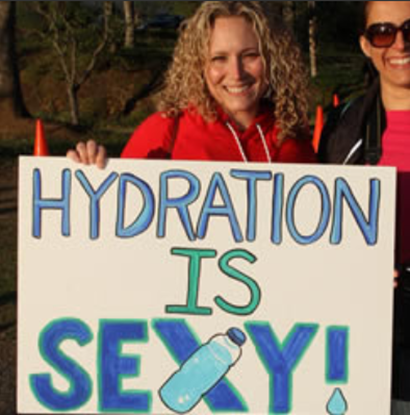
If you’re going to drink what’s on the course then know this:
- Gulping a sports drink could lead to stomach pains
- Large intake of carbohydrates like gels and sports drinks while running cause runners trots
- Try alternating grabbing the sports drink and water from aid stations
What do you carry for hydration?
How much do you drink on the run?
Other ways to connect with Amanda
Instagram Daily Fun: RunToTheFinish
Facebook Community Chatter: RunToTheFinish
Sign Up to Receive a Weekly Newsletter with Top Running Tips
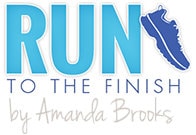
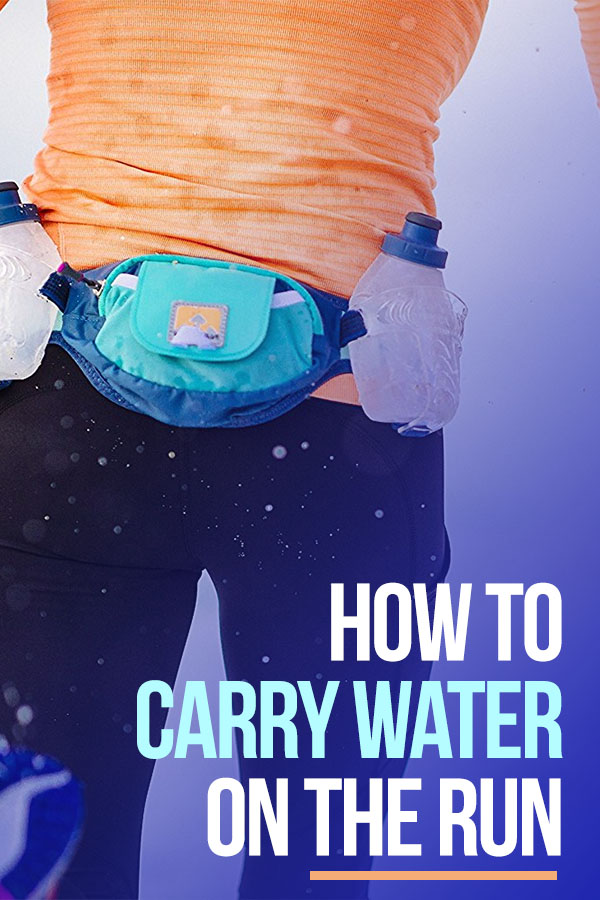

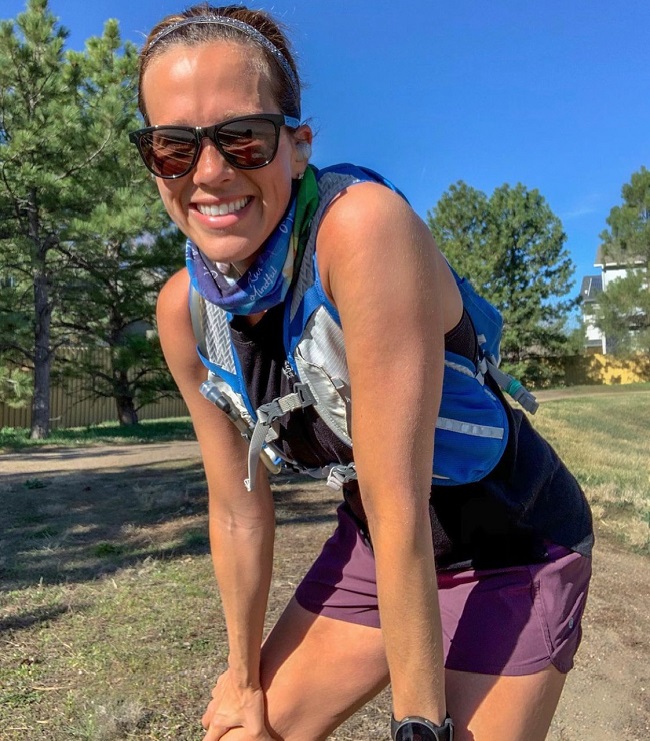
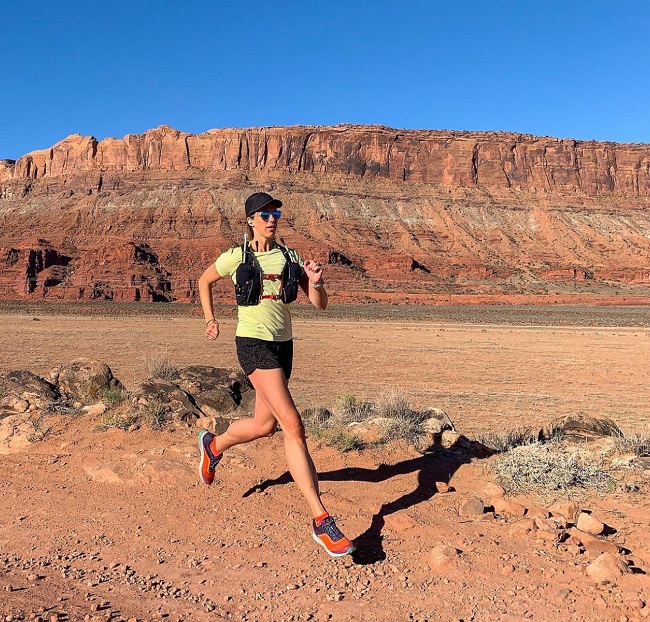
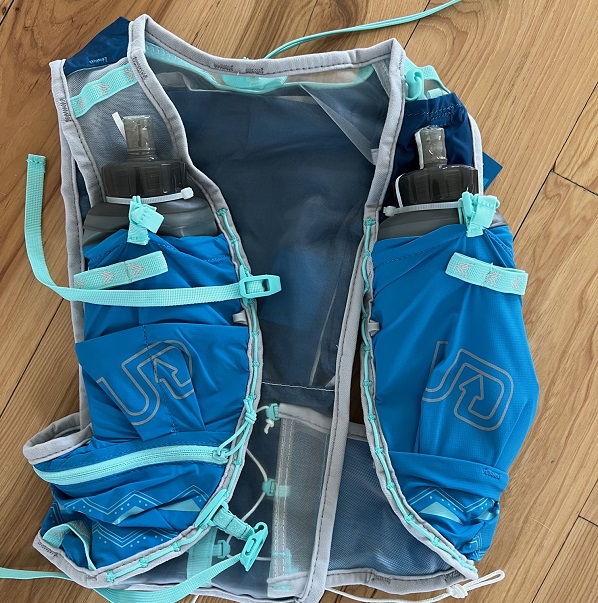
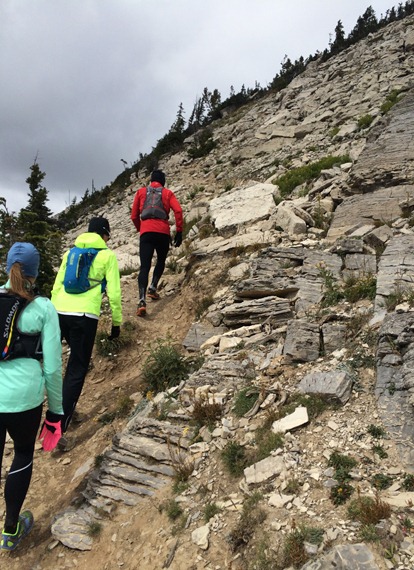

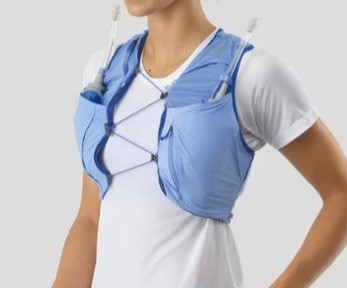
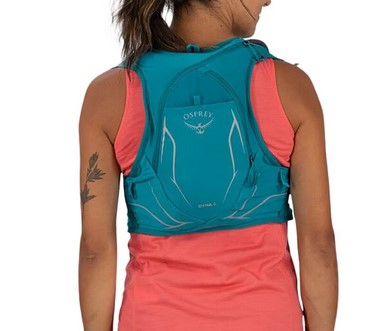
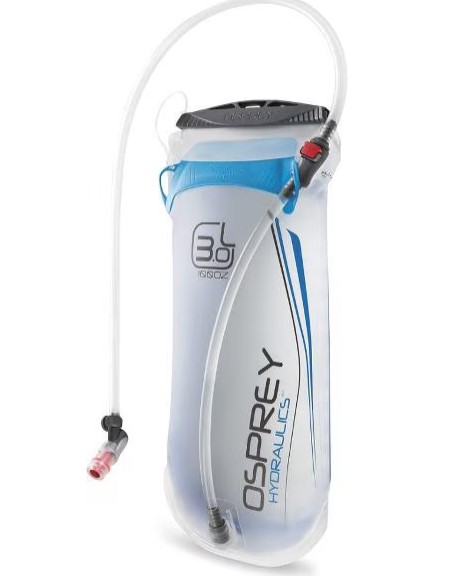
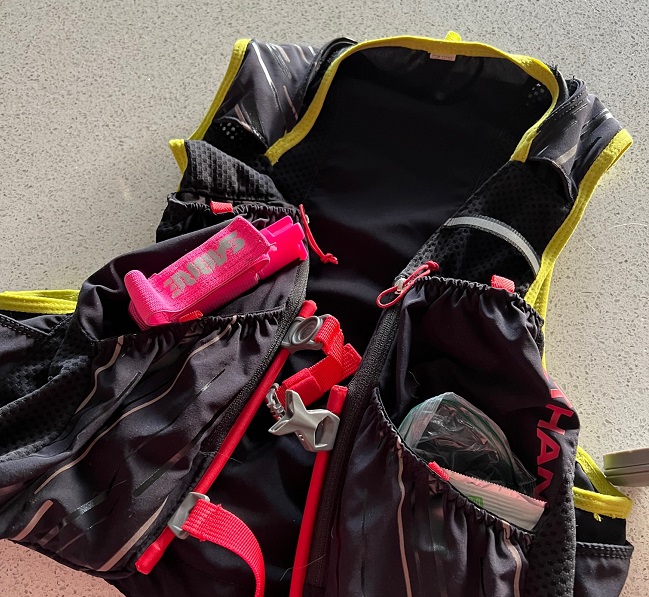
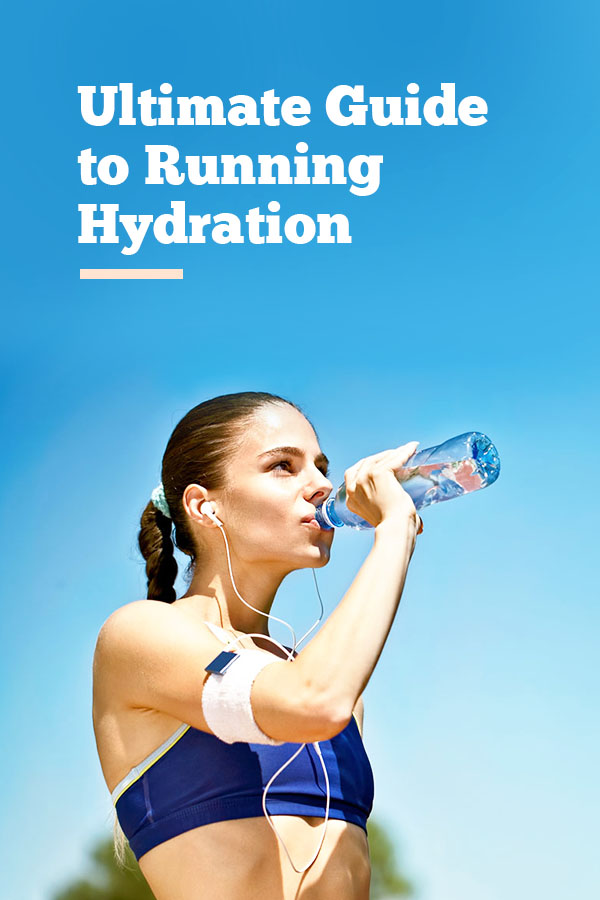
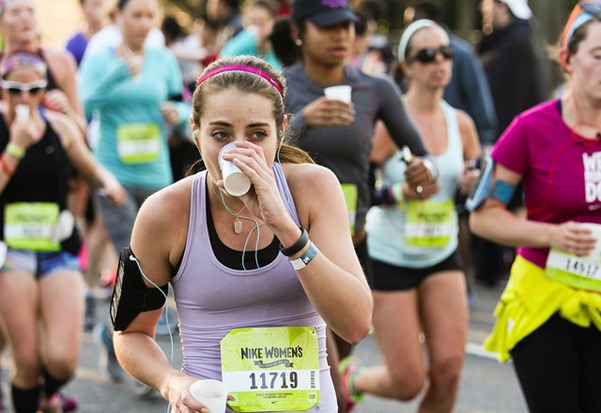

 7 Best Ladder Drills for Runners (Speed and Agility Drills)
7 Best Ladder Drills for Runners (Speed and Agility Drills)